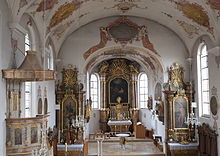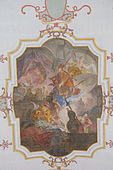St. Nikolaus (Stadtbergen)
The Catholic parish church of St. Nikolaus in Stadtbergen , a town in the Augsburg district in the Bavarian administrative district of Swabia , was built in 1730/31 on the site of a previous late Gothic church. In 1905/06 the baroque nave was extended by two bays to the west. The church is dedicated to St. Nicholas of Myra and can also be found in Stadtbergen's coat of arms .
architecture
Exterior construction
The lower storeys of the 35 meter high bell tower, built on a square floor plan, go back to the predecessor church of the late 14th or early 15th century. Glare fields have been cut into the tower facade, which are framed by pointed arch friezes and corner pilasters . The penultimate floor of the tower is broken through on all four sides by double acoustic arcades .
The baroque door leaves have been preserved on the portals on the north and south sides of the nave . The fittings of the north portal date from the 17th century, those of the south portal from 1730.
inner space
The single nave nave is - like the retracted choir - covered by a basket arch barrel . A double gallery forms the western end of the nave. The stucco decoration by Andreas Hainz, which frames the ceiling frescoes, grisaille and inscription cartouches with banding , was renewed in its original version in strong red-brown during the restoration in 1980/81.
Ceiling painting
The frescoed ceilings in the choir and in the eastern part of the nave were made by Johann Georg Bergmüller , who was director of the Augsburg Art Academy from 1730 until his death in 1762 .
On the central choir fresco, Lucifer's fall from hell by the Archangel Michael symbolizes the triumph of the cross. The scene in the northern vaulted gusset shows Saint Helena , mother of Emperor Constantine the Great , and the Bishop of Jerusalem, Makarios I , checking the true cross for authenticity. On the southern gusset of the vault you can see the Byzantine emperor Herakleios , who in 630 brought the cross relic back to Jerusalem in a solemn procession. The grisaille paintings recall episodes from the Old Testament such as the sacrifice of Isaac by Abraham , the bronze serpent and Samson with the gates of the city of Gaza.
The ceiling fresco in the eastern part of the nave is dedicated to the patron saint of the church, St. Nicholas. The saint appears to Emperor Constantine the Great in a dream so that he might release three unjustly convicted soldiers.
The ceiling paintings in the western nave, which was added in 1906, also refer to the legend of St. Nicholas. The large western nave fresco by Joseph Albrecht depicts the death of the saint. Six smaller pictures remind of his miracles. The lamb of God and the tree of knowledge are depicted in the vaulting, above the gallery King David with the harp and Saint Cecilia at the organ .
Furnishing
- The holy water font at the north portal is a cube capital from the 13th century. On the front is a tartsche with a stonemason's mark from the 16th century.
- The oldest sculpture in the church, the carved wood figure of Saint Nicholas , depicted with his attribute , the three golden spheres, is dated around 1520.
- The figure of St. Urban , the weather patron, dates from the 17th century .
- The diocese saints of the Diocese of Augsburg , Saint Ulrich and Saint Afra , are works from the time the church was built.
- The high altar from 1702/10 was originally created for the Jesuit church St. Salvator in Augsburg. It was only acquired by the pastor for the Stadtbergen church at the beginning of the 19th century. The altarpiece is a copy of the Holy Night by Antonio da Correggio .
- The pulpit was made around 1725/30 by the Augsburg sculptor Andreas Hainz.
- The oval paintings on the nave walls , on each of which two apostles are depicted, were made by Johann Georg Wolcker in 1735 . Wolker also painted the altar sheet on the left side altar with the depiction of the veneration of Mary by St. Nicholas and John Nepomuk .
- The late baroque oak church stalls have carved wood cheeks that are decorated with bands, acanthus leaves and putti .
- The baptismal font made of marbled wood with Rocailles decor from the middle of the 18th century is crowned by a carved group of the baptism of Jesus .
organ
The organ building company Heiss (Vöhringen) is currently building a new organ . The instrument will have 19 stops on two manual works and a pedal .
|
|
|
||||||||||||||||||||||||||||||||||||||||||||||||||||||||||||||||
literature
- Georg Dehio : Handbook of German Art Monuments - Bavaria III - Swabia (arr.: Bruno Bushart, Georg Paula) . 2nd Edition. Deutscher Kunstverlag, Munich 1989, ISBN 978-3-422-03116-6 , p. 959-960 .
- Anton Schneider: Parish Church of St. Nikolaus Stadtbergen. Stadtbergen 2011.
Web links
Individual evidence
- ^ Diocese of Augsburg
- ↑ Information about the organ on the website of the organ builder
Coordinates: 48 ° 21 '52.1 " N , 10 ° 50' 36.6" E








